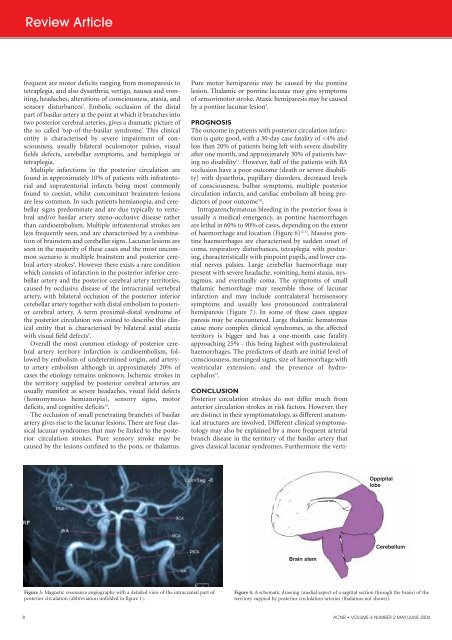An Anatomico-Clinical Overview - Advances in Clinical ...
An Anatomico-Clinical Overview - Advances in Clinical ...
An Anatomico-Clinical Overview - Advances in Clinical ...
You also want an ePaper? Increase the reach of your titles
YUMPU automatically turns print PDFs into web optimized ePapers that Google loves.
Review Article<br />
frequent are motor deficits rang<strong>in</strong>g from monoparesis to<br />
tetraplegia, and also dysarthria, vertigo, nausea and vomit<strong>in</strong>g,<br />
headaches, alterations of consciousness, ataxia, and<br />
sensory disturbances 7 . Embolic occlusion of the distal<br />
part of basilar artery at the po<strong>in</strong>t at which it branches <strong>in</strong>to<br />
two posterior cerebral arteries, gives a dramatic picture of<br />
the so called ‘top-of-the-basilar syndrome’. This cl<strong>in</strong>ical<br />
entity is characterised by severe impairment of consciousness,<br />
usually bilateral oculomotor palsies, visual<br />
fields defects, cerebellar symptoms, and hemiplegia or<br />
tetraplegia.<br />
Multiple <strong>in</strong>farctions <strong>in</strong> the posterior circulation are<br />
found <strong>in</strong> approximately 10% of patients with <strong>in</strong>fratentorial<br />
and supratentorial <strong>in</strong>farcts be<strong>in</strong>g most commonly<br />
found to coexist, whilst concomitant bra<strong>in</strong>stem lesions<br />
are less common. In such patients hemianopia, and cerebellar<br />
signs predom<strong>in</strong>ate and are due typically to vertebral<br />
and/or basilar artery steno-occlusive disease rather<br />
than cardioembolism. Multiple <strong>in</strong>fratentorial strokes are<br />
less frequently seen, and are characterised by a comb<strong>in</strong>ation<br />
of bra<strong>in</strong>stem and cerebellar signs. Lacunar lesions are<br />
seen <strong>in</strong> the majority of these cases and the most uncommon<br />
scenario is multiple bra<strong>in</strong>stem and posterior cerebral<br />
artery strokes 8 . However there exists a rare condition<br />
which consists of <strong>in</strong>farction <strong>in</strong> the posterior <strong>in</strong>ferior cerebellar<br />
artery and the posterior cerebral artery territories,<br />
caused by occlusive disease of the <strong>in</strong>tracranial vertebral<br />
artery, with bilateral occlusion of the posterior <strong>in</strong>ferior<br />
cerebellar artery together with distal embolism to posterior<br />
cerebral artery. A term proximal-distal syndrome of<br />
the posterior circulation was co<strong>in</strong>ed to describe this cl<strong>in</strong>ical<br />
entity that is characterised by bilateral axial ataxia<br />
with visual field defects 9 .<br />
Overall the most common etiology of posterior cerebral<br />
artery territory <strong>in</strong>farction is cardioembolism, followed<br />
by embolism of undeterm<strong>in</strong>ed orig<strong>in</strong>, and arteryto<br />
artery embolism although <strong>in</strong> approximately 20% of<br />
cases the etiology rema<strong>in</strong>s unknown. Ischemic strokes <strong>in</strong><br />
the territory supplied by posterior cerebral arteries are<br />
usually manifest as severe headaches, visual field defects<br />
(homonymous hemianopia), sensory signs, motor<br />
deficits, and cognitive deficits 10 .<br />
The occlusion of small penetrat<strong>in</strong>g branches of basilar<br />
artery gives rise to the lacunar lesions. There are four classical<br />
lacunar syndromes that may be l<strong>in</strong>ked to the posterior<br />
circulation strokes. Pure sensory stroke may be<br />
caused by the lesions conf<strong>in</strong>ed to the pons, or thalamus.<br />
Figure 3. Magnetic resonance angiography with a detailed view of the <strong>in</strong>tracranial part of<br />
posterior circulation (abbreviation unfolded <strong>in</strong> figure 1).<br />
Pure motor hemiparesis may be caused by the pont<strong>in</strong>e<br />
lesion. Thalamic or pont<strong>in</strong>e lacunae may give symptoms<br />
of sensorimotor stroke. Ataxic hemiparesis may be caused<br />
by a pont<strong>in</strong>e lacunar lesion 4 .<br />
PROGNOSIS<br />
The outcome <strong>in</strong> patients with posterior circulation <strong>in</strong>farction<br />
is quite good, with a 30-day case fatality of

















